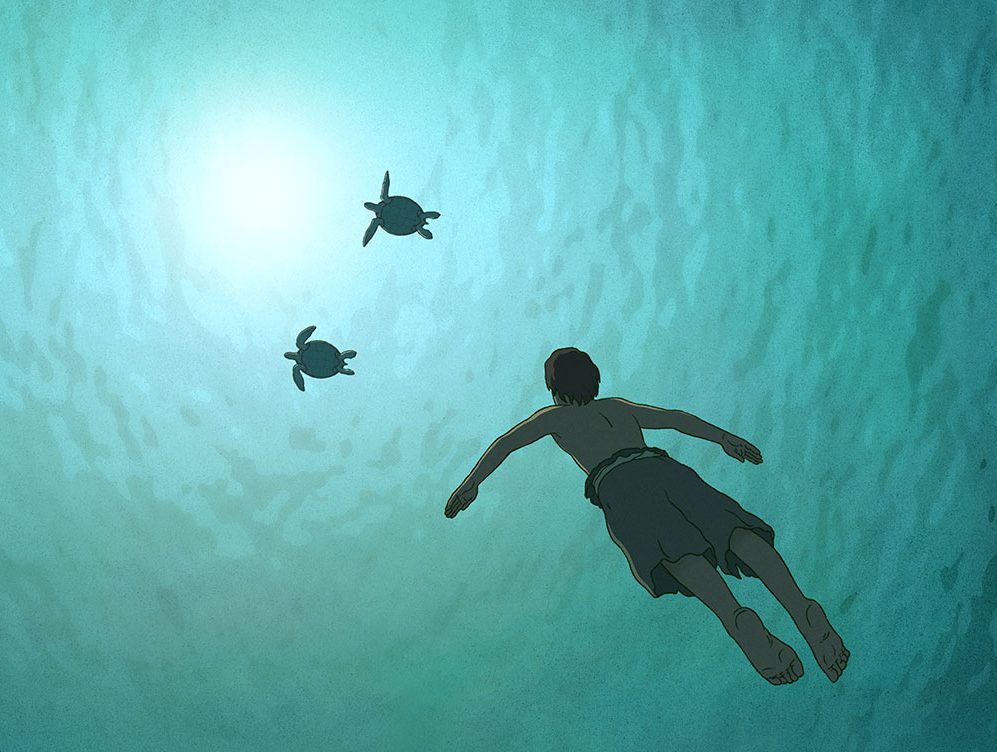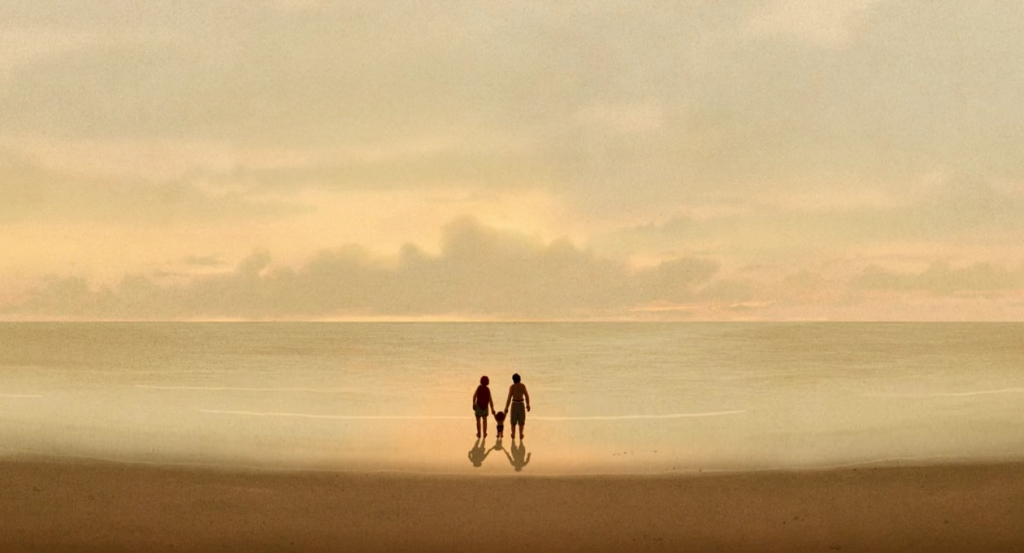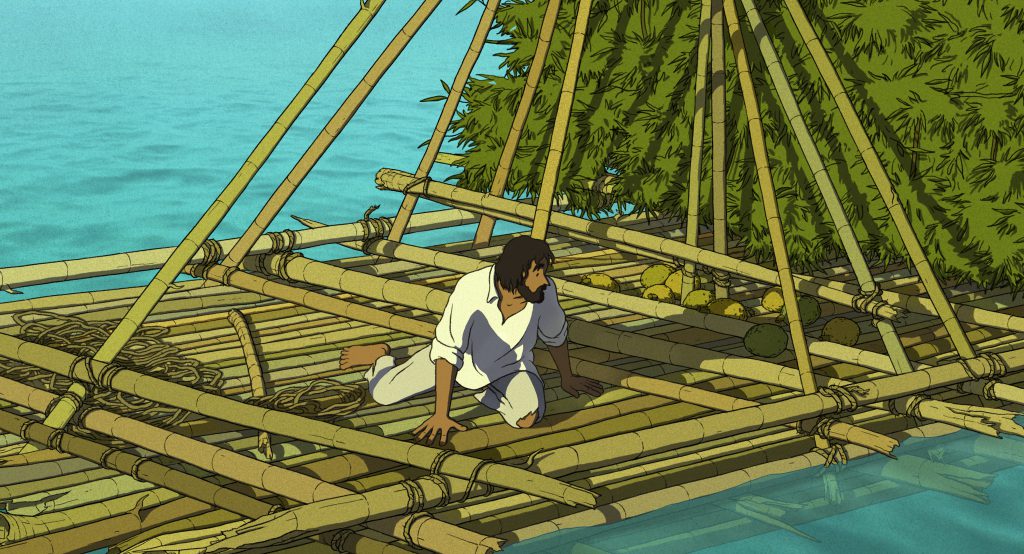
The following is brought to us by Japanese film veteran Jeremiah Lawson, a look at the Oscar-nominated film The Red Turtle.
There are times when you simply have to spoil the entire film in a few sentences to even discuss the film in a meaningful way. Where some reviewers hedge and equivocate as to what the core of the story for The Red Turtle is, I’m going to put in simple terms.
Think of the world as an island; then think of the island as being embodied in flesh and spirit by a red turtle. The Red Turtle — a feature-length film from Studio Ghibli co-produced with Wild Bunch — begins with a man lost at sea. Whether shipwrecked or not, we have no idea. He is cast upon the island and, after hallucinating that a string quartet is with him, tries to escape repeatedly. Every time, he is thwarted by something that destroys his rafts. The third time he sees that the thing destroying the rafts is a giant red turtle.
Angry that the red turtle entraps him on the island with her, he is tempted to kill her. Instead, he rolls her on her back. The turtle may or may not be dead. One day he wakes up, and from the cracked shell of the turtle a woman is revealed, and he rescues her from death. The two fall in love and birth a child together. The boy grows up and leaves the island in search of other people. The man and the woman grow old together and die. In their hour of death, we see the woman was the red turtle all along. The end.
When I watched the film in the theater and the final revealing shot hit the screen, I heard a woman behind me say “Ew.” Given the correspondence of the red between the woman’s hair and the shell of the titular red turtle, I anticipated this plot reveal (you can’t even call it a twist) before I saw the film. No one familiar with the Japanese stories of animal spirits and humans siring children together would have failed to see this trope coming; but it’s just weird and squicky enough for Western reviewers who have taken up the cause of The Red Turtle to avoid mentioning it.
Now you can have a moon spirit in a romance with a man in Legend of Princess Kaguya or in the highly Westernized riff on the core story in Kubo and the Two Strings. Like The Red Turtle, Kubo was in contest for best animated feature. Still, in both cases we’re looking at mostly human/human romances, not the shape-shifting animal-spirit/human romance that we’re given in The Red Turtle.
For Western audiences who aren’t already familiar with the anime trope of the animal spirit taking humanoid form to bring a human/spirit hybrid child into the world, The Red Turtle might be the most benign variant of this trope you could ask for. Well, there’s Ponyo, the fish-girl who chooses to become human. Both Studio Ghibli tales are simpler and less creepy for an uninitiated viewer than, say, Hakkenden. Still, any film review that doesn’t tell you about the man and the red turtle and their love child is holding back some pretty basic information about the story.
Now I know reviewers have said it’s never entirely clear whether this really happened or whether the man has hallucinated everything in his desire for company. Fair point for veteran viewers of anime — but that final scene in which the woman’s hand disappears and is replaced by the turtle’s flipper is not something you can just ignore. As a fable of how the world rests upon the back of a turtle, or how humanity and nature must build lives together, it’s still pretty straightforward, but there’s something too Western middle-class stages-of-life about the film to entirely come off that way.
This is director Michaël Dudok de Wit’s first feature-length film, so the sheer beauty of it suggests we’ll see more like this from him. But this is a film that disappoints in its beauty, not in its failure to do justice to Tales of Earthsea (another rare disappointment in the Studio Ghibli filmography). We should be generous to directors tackling such challenging subject matter in first films.
Even so, after finishing the film, I couldn’t shake the sense that this film is beautiful but not sublime in the way many of us have come to expect of Studio Ghibli films. If it is sublime, then it’s sublime in the sense of the term in chemistry, where we have something solid that vaporizes as soon as it’s subjected to any heat.
As Edmund Burke legendarily put it, the beautiful and the sublime are not really the same thing. For something to be sublime there must be a capacity, however directly or indirectly, for that abject feeling we know as terror. We don’t really get this much in The Red Turtle. Sure, the man could drown at sea, but the trailer showed us he didn’t. Sometimes trailers really do give away the entire film before its release, and there’s no film in the last few years more harmed by this trend than The Red Turtle. If you see the man with a woman and a child in the trailer you expect them to show up in the film either as a flashback or within the events of the story that unfolds. You can’t have real suspense if the question is merely “when” the man will meet the woman and have the child and everything will turn out alright.
For that matter if the turtle sought to kill and eat the man, there would be a different film, or no film at all. If the man killed the turtle and cooked her meat for food, there would have been a movie but a movie unable to traffic in what may be thought of as a kind of morally therapeutic animism or pantheism. That the man and the woman spend decades on an island with nothing more than the natural resources of the island itself and never get food poisoning stretches disbelief. They only have one child and never have arguments. Nobody uses more than monosyllabic vocal utterances through the entire film. There’s a leaving-the-nest scene for the child but without dialogue we are asked to not think about why this man has learned so much about raft-building and sailing and yet never learned to use words. The narrative and characterization are vivid and memorable but iconic to a fault. This is a family in which there can be no sibling rivalries or marital strife — for Christians and Jews, the first siblings ever to be born were also associated with the first murder.
But even if we cast about for stories from within the Studio Ghibli filmography, we discover that what makes these films sublime is a capacity, however often latent, for terror. The king of the forest in My Neighbor Totoro has a fearsome set of claws and a giant toothy mouth. He could swallow Mei and her big sister whole. That the king of the forest doesn’t do this is a source of delight. Edmund Burke would remind us that the delight comes from knowing that the powerful forest-god could kill the children but is benevolent and chooses not to. Yet we see in another Miyazaki film, Princess Mononoke, that when the forest-god is angry enough or suffers an assassination attempt at the hands of humans, he can turn upon humans and the entire forest with an all-devouring wrath.
Miyazaki’s films don’t merely give us stories in which the divine can break forth into wrath; they also give us humans capable of moral evil and good. Lady Eboshi can be a hero to lepers by giving them meaningful work even as she cuts down the forest and tries to assassinate the forest god in Princess Mononoke. Chihiro’s parents display a gluttony and avarice that transforms them into pigs in Spirited Away, metaphorical and literal pigs trapped in a spirit world from which their daughter Chihiro must save them even after she has had her name taken from her by a witch. The engineer Jiro can design beautiful planes that he knows will be used to kill millions but believes that his work is still worthy and beautiful, and he also displays generosity to strangers while alienating his family.
Miyazaki’s gods and humans may choose to extend mercy to those who don’t deserve it; by contrast, in The Red Turtle everyone basks in the glow of a world that is full of beauty but bereft of real terror. The film is beautiful, even mesmerizing in its beauty, but it can’t overcome the significance of an audience going the distance and learning that this castaway lived his whole life and died stranded on an island, possibly hallucinating a romantic cycle of life with what may only have been the corpse of a giant red turtle. The elegant, wistful soundtrack at the end of the film urges us to consider the beauty in a way that may not give us room to consider the possibility of terror, that every beautiful experience the man has in the story has only been a hallucination from his own thought life.

COMMENTS
Leave a Reply














